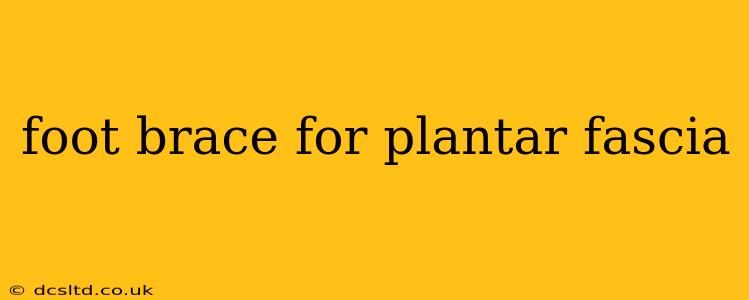Plantar fasciitis, that nagging heel pain, affects millions. Finding the right foot brace can be the key to managing this condition and getting back on your feet comfortably. This comprehensive guide will explore everything you need to know about selecting and using a foot brace for plantar fasciitis, helping you find the perfect solution for your needs.
What is Plantar Fasciitis?
Plantar fasciitis is a common condition characterized by inflammation of the plantar fascia, a thick band of tissue on the bottom of your foot that connects your heel bone to your toes. This inflammation causes pain, most noticeably in the heel, often worse in the mornings or after periods of rest. Overuse, improper footwear, tight calf muscles, and even obesity can contribute to its development.
What are the Different Types of Foot Braces for Plantar Fasciitis?
Several types of foot braces offer varying levels of support and can be beneficial for plantar fasciitis:
1. Night Splints:
These braces are worn at night to gently stretch the plantar fascia and reduce morning stiffness. They hold your foot at a 90-degree angle, preventing the plantar fascia from tightening overnight.
2. Arch Supports (Insoles):
These are placed inside your shoes and provide arch support, distributing weight evenly across your foot and reducing strain on the plantar fascia. They come in various materials, from simple foam to more supportive designs incorporating medical-grade materials.
3. Heel Cups:
These are smaller inserts that primarily focus on cushioning the heel and reducing pressure on the plantar fascia. Often made of gel or foam, they offer targeted support.
4. Full-Length Orthotics:
These custom-made or prefabricated inserts provide comprehensive support across the entire foot, addressing issues like arch height, pronation, and overall foot mechanics. They are typically more expensive but offer superior support and correction.
What are the Benefits of Using a Foot Brace for Plantar Fasciitis?
Using a foot brace offers several key benefits for managing plantar fasciitis:
- Pain Relief: By providing support and cushioning, braces reduce stress on the inflamed plantar fascia, lessening pain.
- Reduced Inflammation: Proper support promotes better blood flow, aiding in the healing process and reducing inflammation.
- Improved Foot Mechanics: Braces help correct biomechanical issues that contribute to plantar fasciitis, preventing future occurrences.
- Increased Comfort: By providing better support and cushioning, foot braces increase comfort, especially during activities.
How Do I Choose the Right Foot Brace?
Choosing the right foot brace depends on several factors:
- Severity of your condition: Mild cases may benefit from simple heel cups or arch supports, while more severe cases might require custom orthotics.
- Your activity level: If you're highly active, you might need a more supportive brace.
- Your footwear: Consider the type of shoes you typically wear and choose a brace compatible with them.
- Your budget: Prices vary widely depending on the type and quality of the brace.
How to Use a Foot Brace Effectively
Proper use is crucial for optimal results:
- Start slowly: Begin by wearing the brace for short periods and gradually increase the duration.
- Wear the brace consistently: Consistent use is essential for effective pain management.
- Ensure proper fit: The brace should fit comfortably without causing discomfort.
- Choose the right shoes: Select footwear that accommodates the brace and provides adequate support.
- Consult with a podiatrist: A podiatrist can assess your condition, recommend the best brace, and provide additional treatment options.
What Other Treatments Are Available for Plantar Fasciitis?
While foot braces are a cornerstone of treatment, other methods can help:
- Physical therapy: Exercises can strengthen your calf muscles and improve foot flexibility.
- Medication: Over-the-counter anti-inflammatory drugs or prescription medications may be necessary.
- Corticosteroid injections: These can provide short-term pain relief but are not a long-term solution.
- Surgery: Surgery is rarely needed but may be an option in severe, unresponsive cases.
Are There Any Risks Associated with Using Foot Braces?
Foot braces are generally safe, but some potential risks include:
- Allergic reactions: Some materials used in brace construction can cause allergic reactions.
- Skin irritation: Improper fit or poor-quality materials can cause skin irritation.
- Temporary discomfort: Initially, you might experience some discomfort as your feet adjust to the brace.
How Much Do Foot Braces Cost?
The cost of a foot brace varies greatly depending on the type:
- Simple heel cups: $10-$30
- Arch supports: $20-$50
- Custom orthotics: $300-$600 or more
Remember, investing in a quality brace from a reputable source can significantly impact your long-term comfort and recovery.
This information is for general knowledge and does not constitute medical advice. Always consult a healthcare professional for diagnosis and treatment of plantar fasciitis.
